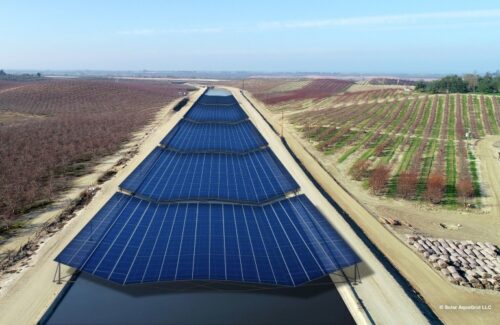Turlock Irrigation District (TID) in Turlock, California, is planning the country’s first pilot project to build solar panel canopies over a portion of the water utility’s existing canals. Project Nexus is planned as a multi-use solar project, assessing water evaporation reduction from mid-day shade and wind mitigation; improvements to water quality and reduced canal maintenance through reduced vegetative growth; and generating renewable energy.

Conceptual rendering of solar panels spanning the 110 foot-wide TID Main Canal. Project Nexus
Project Nexus is a public-private-academic partnership among TID, the Department of Water Resources (DWR), Solar AquaGrid and the University of California, Merced. Groundbreaking on Project Nexus is scheduled for this fall, with project completion expected in 2024 at multiple locations throughout the TID service territory in California’s Central Valley. The project will use existing TID infrastructure on already-disturbed land to reduce costs and support the region’s sustainable farming tradition. Additionally, energy storage will be installed to study how storage facilities can support the local electric grid when solar generation is suboptimal due to cloud cover. The $20 million project is funded by the state of California.
“In our 135-year history, we’ve always pursued innovative projects that benefit TID water and power customers,” said Michael Frantz, board president of TID. “There will always be reasons to say ‘no’ to projects like this, but as the first public irrigation district in California, we aren’t afraid to chart a new path with pilot projects that have potential to meet our water and energy sustainability goals.”
Project Nexus is seen as a template with the potential to be replicated elsewhere in the state to help California achieve its water and energy goals. The inspiration for Project Nexus comes from the concept presented in a recent University of California study, published last March in the journal Nature Sustainability.
The UC study illustrated that covering all of the approximately 4,000 miles of California canals could show a savings of 63 billion gallons of water annually, comparable to the amount needed to irrigate 50,000 acres of farmland or meet the residential water needs of more than 2 million people. According to the study, the 13 GW of solar power the solar panels would generate each year would equal about one-sixth of the state’s current installed capacity.
“The Solar AquaGrid model provides a combined, integrated response to addressing our water-energy nexus,” said Roger Bales, professor at UC Merced. “It helps address California’s underlying vulnerabilities while meeting both state and federal level commitments to produce renewable energy, preserve natural lands, lower greenhouse gas emissions and mitigate climate change.”
DWR will oversee administering this project, provide technical assistance and serve as a research partner.
“We are excited to explore new efforts to advance the integration of renewable energy into our water supply delivery system,” said Karla Nemeth, director of DWR. “The project offers great potential and we look forward to collaborating with our local and academic partners to advance these type of multi-benefit projects.”
Turlock Irrigation District has retained Bay Area development firm Solar AquaGrid as project developers and program managers for TID and Project Nexus. The two agencies have been collaborating since the project’s inception. Solar AquaGrid originated the project after commissioning the UC Merced Study in 2015 and has facilitated collaboration among the various parties to bring Project Nexus to fruition.
“Research and common sense tell us that in an age of intensifying drought, it’s time to put a lid on evaporation,” said Jordan Harris, CEO of Solar AquaGrid. “We are excited to partner with Turlock Irrigation District, DWR and UC Merced to develop this first-in-the-nation pilot project and bring needed innovation to the Central Valley. Our initial study revealed mounting solar panels over open canals can result in significant water, energy and cost savings when compared to ground-mounted solar systems, including added efficiency resulting from an exponential shading/cooling effect. Now is the chance to put that learning to the test.”
News item from Project Nexus Partners





Loving that this is finally happening. Might I offer two additional technologies to get the biggest bang for the buck, use water generating solar panels (aka Hyndropanel), put more water into the canal. Source dot co is one provider. Also, how about adding in the canal, small whirlpool or hydroelectric, power generator. More water, more power. Win-Win-Win.
We can do this with Mirrors. I have investigated in several Dew Harvesting Methods inklusive Online Calculators of how much Watt you need with these water generating solar panels. We can combine Mirrors ideally with vertical mounted PV Modules, so the surrounding is cooled and the evaporated water will drip back under the backside of the mirrors! See my work about Solar Radiation Management on PV4 dot EU.
I have worked along such an irrigation conveyance and can tell you, from the concept rendering, this is what lawyers call an attractive nuisance. It inhibits repair and maintenance of the canal as well as attracts vandals and thieves who want a free solar PV array. Remote areas along the canal will be attacked first, then as interest in this energy “dream” wanes due to repair and maintenance costs, the vandals and thieves will move closer to inhabited areas to do their dirty work, this will spill over to people’s homes and property near this conveyance, sooner or later the panels will be damaged and forgotten or removed all together.